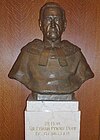This is an old revision of this page, as edited by Damiens.rf (talk | contribs) at 16:35, 10 April 2008 (Adding wikilinks). The present address (URL) is a permanent link to this revision, which may differ significantly from the current revision.
Revision as of 16:35, 10 April 2008 by Damiens.rf (talk | contribs) (Adding wikilinks)(diff) ← Previous revision | Latest revision (diff) | Newer revision → (diff)| Sir Lyman Duff | |
|---|---|
 | |
| Chief Justice of Canada | |
| In office March 17 1933 – January 2 1944 | |
| Preceded by | Francis Anglin |
| Succeeded by | Thibaudeau Rinfret |
| Puisne Justice of the Supreme Court of Canada | |
| In office September 27 1906 – March 17 1933 | |
| Preceded by | Robert Sedgewick |
| Succeeded by | Frank Hughes |
Sir Lyman Poore Duff, PC, GCMG (Ontario, January 7, 1865 – April 26, 1955) was Chief Justice of the Supreme Court of Canada and briefly served as Acting Governor General of Canada in 1931 and 1940.

Born in Meaford, Ontario to a Congregationalist minister, he received a Bachelor of Arts in mathematics and metaphysics in 1887 and a Bachelor of Law in 1889 from the University of Toronto. He was called to the Ontario Bar in 1893. In 1901, he was created a Queen's Counsel. From 1890 to 1895, he was a teacher of math at Barrie Collegiate Institute. He was a lawyer in Fergus, Ontario and moved to Victoria, British Columbia in 1895 to practise law.
In 1904, he was appointed a puisne judge of the Supreme Court of British Columbia. In 1906 was appointed a justice of the Supreme Court of Canada. He was appointed chief justice of Canada in 1933 and retired in 1944.
In 1931, he served as Administrator of the Government of Canada between the departure of Lord Bessborough for India and the arrival of Lord Tweedsmuir. Duff took on the position as the Chief Justice was unavailable. In 1933, Duff he was promoted to Chief Justice. He was knighted the following year as a result of Prime Minister Richard Bennett's temporary suspension of the Nickel Resolution.
When Governor General Lord Tweedsmuir died in office on February 11, 1940, according to the rules of succession, Chief Justice Duff became acting Governor General. He held the office for nearly four months, until Britain appointed a new Governor General on June 21, 1940. Duff was the first Canadian to hold the position, even in the interim. A Canadian Governor General was not appointed until Vincent Massey in 1952.

Further reading
- Williams, David Ricardo (1984). Duff: A Life In The Law. University of British Columbia Press. ISBN 0-7748-0203-0.
References
External links
| Legal offices | ||
|---|---|---|
| Preceded byRobert Sedgewick | Puisne Justice of the Supreme Court of Canada September 27, 1906 – March 17, 1933 |
Succeeded byFrank Hughes |
| Preceded byFrancis Alexander Anglin | Chief Justice of Canada March 17, 1933 – January 2, 1944 |
Succeeded byThibaudeau Rinfret |
| Political offices | ||
| Preceded byThe Lord Tweedsmuir | Acting Governor General of Canada or administrator 1931 and 1940 |
Succeeded byThe Earl of Athlone |
| Chief justices of Canada | |
|---|---|
| The Fitzpatrick court (1906–18) | |
|---|---|
| June 1906 – August 1906: | |
| September 1906 – 1909: | |
| 1909–11: | |
| 1911–18: | |
| The Davies court (1918–24) | |
|---|---|
| 1918–23 | |
| 1923–24 | |
| The Anglin court (1924–1933) | |
|---|---|
| September 1924 – October 1924: | |
| October 1924 – 1927: | |
| 1927–1929: | |
| 1929–1930: | |
| 1930–1931: | |
| 1931–1932: | |
| 1932–1933: | |
| The Duff court (1933–1944) | |
|---|---|
| March 1933 – December 1933: | |
| December 1933 – January 1935: | |
| January 1935 – February 1935: | |
| February 1935 – July 1935: | |
| July 1935 – March 1936: | |
| March 1936 – December 1939: | |
| December 1939 – February 1940: | |
| February 1940 – April 1943: | |
| April 1943 – January 1944: | |